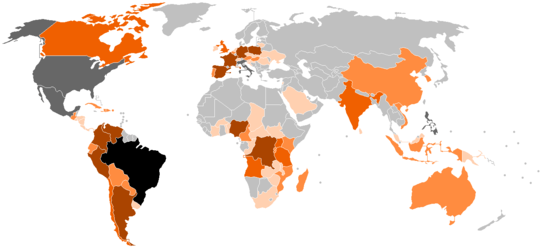Catholic Church in Chile
The Catholic Church in Chile (Spanish: Iglesia católica en Chile) is part of the worldwide Catholic Church, under the spiritual leadership of the Pope, the curia in Rome, and the Episcopal Conference of Chile. There are 5 archdioceses, 18 dioceses, 2 territorial prelatures, 1 apostolic vicariate, 1 military ordinariate and a personal prelature (Opus Dei).
As of 2012, 66.6%[1] of Chilean population over 15 years of age claims to be of Catholic creed - a decrease from the 70%[2] reported by the 2002 census.
Catholicism was introduced by Dominican and Franciscan friars who accompanied the Spanish colonialists in the 16th century. The first parish was established in 1547 and the first diocese in 1561. Most of the native population in the northern and central regions was evangelized by 1650. The southern area proved more difficult. Church activity was hindered during the campaign for independence (1810–18) and in the first years of the new government. In the 20th century, further success was impeded by a shortage of clergy and government attempts to control Church administration. Separation of Church and state was defined by a new constitution in 1925. Relations between Church and state were strained during the Marxist presidency of Salvador Allende and under the military dictatorship of Augusto Pinochet. During the Pinochet regime, while some Catholic bishops and priests supported the regime, others under the leadership of the Archbishop of Santiago, Cardinal Raúl Silva Henríquez, set up the "Vicaria de la Solidaridad" (the "Vicariate of Solidarity"), a human rights organization where "everyone went for help once their loved ones vanished."[3]
There are six Catholic universities in the country: Catholic University of the Most Holy Conception, Catholic University of the Maule, Catholic University of the North, Pontifical Catholic University of Valparaíso, Temuco Catholic University and Pontifical Catholic University of Chile. The latter is considered one of the "World's Best Colleges and Universities" in the 2009 U.S. News & World Report. President Sebastián Piñera, is a graduate of this university.
Several religious orders sponsor a number of secondary and primary schools. One of the most famous is Saint George's College, run by the Congregation of Holy Cross. One third of the CEO's of the top 200 companies of Chile are alumni of Saint George's College.
The Government observes the following Catholic Holy Days as national holidays (if on a week day): Good Friday, Christmas, Feast of the Virgin of Carmen, the Feast of the Immaculate Conception, the Feast of Saints Peter and Paul, the Feast of the Assumption, and All Saints Day.
See also
- Apostolic Nuncio to Chile
- Episcopal Conference of Chile
- List of Roman Catholic dioceses in Chile
- Juventud Parroquial Chilena
Sources
Footnotes
- ↑ 8 236 900 out of 12 366 108 people over 15 years of age. "Population 15 years of age or older, by religion, region, sex and age groups. (censused population)". Censo 2012 (in Spanish). Archived from the original (.xls) on 1 March 2014. Retrieved 1 March 2014.
- ↑ 7 853 428 out of 11 226 309 people over 15 years of age. "Population 15 years of age or older, by religion, administrative division, sex and age groups" (.pdf). Censo 2002 (in Spanish). Retrieved 1 March 2014.
- ↑ Alexei Barrionuevo, "A Serene Advocate for Chile's Disappeared", New York Times, 23 January 2010, 5.
External links
![]() Media related to Roman Catholicism in Chile at Wikimedia Commons
Media related to Roman Catholicism in Chile at Wikimedia Commons
